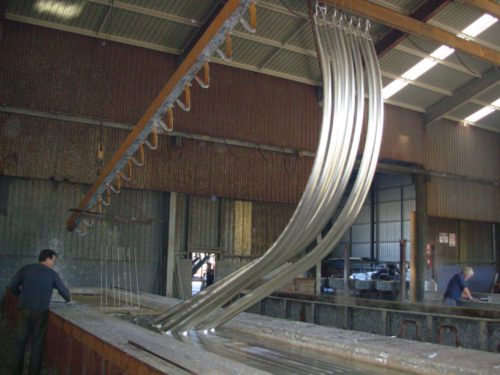Hot dip galvanizing is an important process. It’s one of the ways we can protect steel from corrosion, and it can be a highly effective solution. At G&S Industries, we rely on hot dip galvanization to protect all the steel poles that we supply from undue corrosion. Hot-dipped galvanized steel is used in various applications due to its hardy nature. So, why is hot dip galvanizing so advantageous? Further, exactly what is hot-dipped galvanized steel? If you’re curious, you’ve come to the right place. We will explore what hot dip galvanizing is, why it’s so advantageous, some of its numerous applications, and why it might be chosen over other types of surface finishes.
What is hot dip galvanizing?
To start, it can be helpful to explain what galvanizing is. After all, hot dip is but one method of galvanization.
That’s why understanding why we chose this method can help you understand what any galvanizing method stands to do. Fortunately, that’s pretty easy to answer—it stands to mitigate the risk of rusting.
Galvanizing refers to the coating of steel products with zinc, which is naturally more resistant to corrosion than steel. While zinc does corrode, it forms zinc oxide when it does, which becomes part of a naturally thin layer that protects the rest of the material underneath it from oxidation. While steel may be more prone to corrosion—in the form of rust because of its high iron content—it’s a highly durable, flexible, and strong material, making it ideal in several applications. That’s why combining the two provides the best of both worlds—a durable product with the tensile strength of steel and the corrosion resistance of zinc.
Hot dip galvanizing is one of the most effective and widely used methods of galvanization—for a few reasons that we’ll get into shortly. In creating hot dipped galvanized steel, the steel that is being galvanized is submerged, or dipped, into molten zinc. The molten zinc forms a chemical and physical bond with the steel, creating a very durable coating that is highly resistant to corrosion and physical stress.
Applications for hot dip galvanizing
So, why might we rely on steel that is hot dip galvanized? Why is it so important to protect steel from corrosion? It depends on the application in question, but we often rely on steel because of its impressive tensile strength. As such, we might use steel in places where we need a particularly sturdy structure. If we’re relying on steel because we need structural strength, oxidation and corrosion stand to significantly undermine our efforts by reducing the strength of a material over time. Here are some examples:
Embedded steel
When we embed steel structures—think half-buried underground, underwater, or into a foundation, we can create an environment conducive to the presence of moisture for extended periods of time. This can create an elevated risk of corrosion and oxidation, wreaking havoc on important structures. That’s why hot-dipped galvanized steel may be used in these applications.
Outdoor steel
When steel structures are meant to be left outdoors long-term, it’s important to consider how the elements can affect them. Over time, moisture, heat, and even the presence of UV radiation from sunlight can increase the speed at which steel rusts. That’s why when placing outdoor structures—such as streetlight poles or banner poles, it can be crucial to ensure they’re safeguarded from oxidation through an effective method. Hot-dipped galvanized steel is an often effective solution.
Advantages of hot dip galvanizing
So what are some advantages of an effective galvanizing process, and, beyond that, of hot dip galvanized steel specifically? For galvanizing, in general, it’s quite simple. Zinc is a relatively safe metal—being non-toxic at low doses, easy to work with, and recyclable. Zinc also affords a large degree of protection from corrosion, making it a natural candidate.
Hot dip galvanizing also offers some notable advantages, such as being a relatively simple process and being a galvanizing process that can result in a relatively thick coating of zinc, which can be important for longevity. Further, the immersion of a part means that zinc can coat the insides of parts as well.
Process of hot dip galvanizing
The process of hot dip galvanizing can be broken up into two basic steps, surface treatment and galvanizing.
The surface treatment step is essential, enabling the zinc to react with and bond chemically to the steel. Surface treatment can be broken down further into three distinct steps:
1. Degreasing
This is the first surface preparation step and involves removing grease and other contaminants from the surface of the steel part using a caustic material. Then, any leftover material is rinsed away with water.
2. Pickling
This is the second step in surface preparation, and it involves removing oxidation using acidic materials. Afterwards, leftover material is rinsed away with water.
3. Fluxing
Finally, the steel part is fluxed, removing any additional oxidation, sealing it from oxidation until it’s dipped, and preparing the steel to bond with the zinc coating.
After the surface preparation steps have been completed, it’s time for the galvanizing process. Now, the metal part is immersed in molten zinc. With a melting point of almost 420°C, this zinc bath can be heated to between 430°C and 460°C. The part is left submerged until the temperature has equalised, after which point it’s typically removed.
The Bottom Line
Hot dip galvanizing is an important part of what we do, so exploring why we rely on this effective anti-corrosion process can be important. Hot dip galvanization can provide steel parts and components with considerable protection from corrosion for years, making this method an ideal choice for outdoor steel structures and embedded steel components.
Hot dip corrosion is a relatively simple process, yet it can be important to understand—as its benefits largely stem from how it’s carried out. We can achieve impressive corrosion resistance and longevity by submerging steel parts that have had their surfaces properly prepared through degreasing, pickling, and oxidation completely in a molten bath of zinc at the right temperature for the right amount of time.

